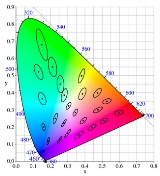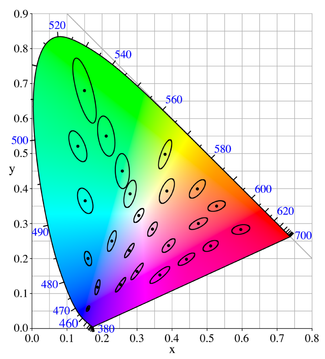
MacAdam ellipse
Encyclopedia
In the study of color vision
, MacAdam ellipses refer to the region on a chromaticity diagram which contains all colors which are indistinguishable, to the average human eye, from the color at the center of the ellipse. The contour of the ellipse therefore represents the just noticeable difference
s of chromaticity
.

is it?". In other words, we wish to develop a method of specifying a particular color which allows us to differentiate it from all other colors. It has been found that three quantities are needed to specify a particular color. For example, the relative amounts of red, green and blue in a color will serve to specify that color completely. This question was first approached by a number of researchers in the 1930's and their results were formalized in the specification of the CIE XYZ color space.
The second question we might ask, given two colors, is "how different are these two colors?" Just as the first question was answered by developing a color space
in which three numbers specified a particular color, we are now asking effectively, how far apart these two colors are. This particular question was considered by researchers dating back to Helmholtz and Schrödinger, and later in industrial applications, however experiments by Wright and Pitt, and David MacAdam
provided much-needed empirical support.
of about 48 cd/m2. One of the colors (the "test" color) was fixed, but the other was adjustable by the observer, and the observer was asked to adjust that color until it matched the test color. This match was, of course, not perfect, since the human eye, like any other instrument, has limited accuracy. It was found by MacAdam, however, that all of the matches made by the observer fell into an ellipse on the CIE 1931 chromaticity diagram. The measurements were made at 25 points on the chromaticity diagram, and it was found that the size and orientation of the ellipses on the diagram varied widely depending on the test color. These 25 ellipses measured by MacAdam, for a particular observer are shown on the chromaticity diagram above.
could be measured using a metric
in a chromaticity space. A number of attempts have been made to define a color space which is not as distorted as the CIE XYZ space. The most notable of these are the CIELUV and CIELAB color spaces. Although both of these spaces are less distorted than the CIE XYZ space, they are not completely free of distortion. This means that the MacAdam ellipses become nearly (but not exactly) circular in these spaces.
Color vision
Color vision is the capacity of an organism or machine to distinguish objects based on the wavelengths of the light they reflect, emit, or transmit...
, MacAdam ellipses refer to the region on a chromaticity diagram which contains all colors which are indistinguishable, to the average human eye, from the color at the center of the ellipse. The contour of the ellipse therefore represents the just noticeable difference
Just noticeable difference
In psychophysics, a just noticeable difference, customarily abbreviated with lowercase letters as jnd, is the smallest detectable difference between a starting and secondary level of a particular sensory stimulus...
s of chromaticity
Chromaticity
Chromaticity is an objective specification of the quality of a color regardless of its luminance, that is, as determined by its hue and colorfulness ....
.

History
In the study of color perception, the first question that usually comes to mind is "what colorColor
Color or colour is the visual perceptual property corresponding in humans to the categories called red, green, blue and others. Color derives from the spectrum of light interacting in the eye with the spectral sensitivities of the light receptors...
is it?". In other words, we wish to develop a method of specifying a particular color which allows us to differentiate it from all other colors. It has been found that three quantities are needed to specify a particular color. For example, the relative amounts of red, green and blue in a color will serve to specify that color completely. This question was first approached by a number of researchers in the 1930's and their results were formalized in the specification of the CIE XYZ color space.
The second question we might ask, given two colors, is "how different are these two colors?" Just as the first question was answered by developing a color space
Color space
A color model is an abstract mathematical model describing the way colors can be represented as tuples of numbers, typically as three or four values or color components...
in which three numbers specified a particular color, we are now asking effectively, how far apart these two colors are. This particular question was considered by researchers dating back to Helmholtz and Schrödinger, and later in industrial applications, however experiments by Wright and Pitt, and David MacAdam
David MacAdam
Dr. David Lewis MacAdam was an American physicist and color scientist who made important contributions to color science and technology in the fields of colorimetry, color discrimination, color photography and television, and color order.-Education:MacAdam grew up in Philadelphia, attended Lehigh...
provided much-needed empirical support.
Procedure
MacAdam set up an experiment in which a trained observer viewed two different colors, at a fixed luminanceLuminance
Luminance is a photometric measure of the luminous intensity per unit area of light travelling in a given direction. It describes the amount of light that passes through or is emitted from a particular area, and falls within a given solid angle. The SI unit for luminance is candela per square...
of about 48 cd/m2. One of the colors (the "test" color) was fixed, but the other was adjustable by the observer, and the observer was asked to adjust that color until it matched the test color. This match was, of course, not perfect, since the human eye, like any other instrument, has limited accuracy. It was found by MacAdam, however, that all of the matches made by the observer fell into an ellipse on the CIE 1931 chromaticity diagram. The measurements were made at 25 points on the chromaticity diagram, and it was found that the size and orientation of the ellipses on the diagram varied widely depending on the test color. These 25 ellipses measured by MacAdam, for a particular observer are shown on the chromaticity diagram above.
Extension to three dimensions
A more general concept is that of "discrimination ellipsoids" in the entire three dimensional color space, which would include the ability of an observer to discriminate between two different luminances of the same color. Such measurements were carried out, among others, by Brown and MacAdam in 1949, Davidson in 1951, Brown in 1957, and by Wyszecki and Fielder in 1971. It was found that the discrimination ellipsoids yielded relatively unchanging discrimination ellipses in chromaticity space for luminances between 3 and 30 cd/m2.Effects in color theory
MacAdam's results confirmed earlier suspicions that color differenceColor difference
The difference or distance between two colors is a metric of interest in color science. It allows people to quantify a notion that would otherwise be described with adjectives, to the detriment of anyone whose work is color critical...
could be measured using a metric
Metric (mathematics)
In mathematics, a metric or distance function is a function which defines a distance between elements of a set. A set with a metric is called a metric space. A metric induces a topology on a set but not all topologies can be generated by a metric...
in a chromaticity space. A number of attempts have been made to define a color space which is not as distorted as the CIE XYZ space. The most notable of these are the CIELUV and CIELAB color spaces. Although both of these spaces are less distorted than the CIE XYZ space, they are not completely free of distortion. This means that the MacAdam ellipses become nearly (but not exactly) circular in these spaces.

